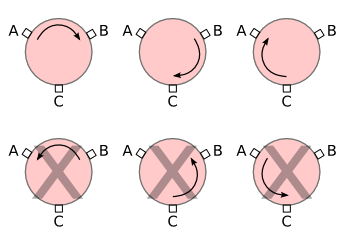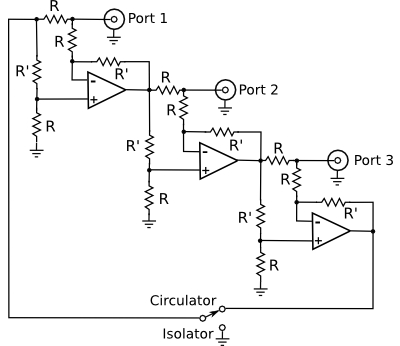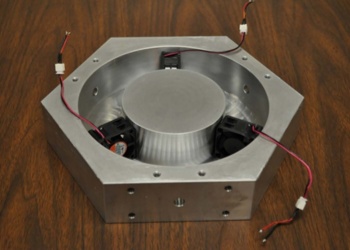Acoustic Circulator
March 3, 2014
Circulators are common
microwave devices distinguished by being
passive (no
power required) and
non-reciprocal. The non-reciprocal property means that
radio frequency energy in a circulator travels on a
one-way street; that is, you can easily conduct signals from point "A" to point "B," but the reverse signal direction is blocked. The operation of a three-port circulator is illustrated in the figure.

In a circulator, radio frequency energy "circulates" in either a clockwise or counter-clockwise fashion.
You can conduct signals between adjacent ports in just one direction.
(Illustration by the author using Inkscape.)
Such an operating principle is possible, since circulators contain materials for which
electromagnetic wave propagation is not
rotationally symmetric. For radio frequencies, this is
ferrite,
biased in a
magnetic field. For
optical circulators, there's also a magnetic field, but the material is an
optical Faraday rotator, such as
terbium aluminum garnet. These materials cause a
phase shift between left and right
circularly polarized counter-rotating waves injected at an input port, so signals will reinforce in one direction, and cancel in the other. This means, also, that signals will be conducted from "A" to "B," but not "A" to "C."
One obvious application of a circulator is as an
isolator, which can be used, for example, at the output of an
oscillator to prevent its being detuned by downstream
circuitry. The most useful application is as a means of using a
transmitter and
receiver with the same
antenna. With proper port connection, signals from a transmitter will be conducted by a circulator to the antenna, only, and not to a receiver with connection to the same circulator.
If you're working with low frequencies, which may even be as high as a 100
MHz, it's possible to build a circulator with commonly available components. The circulator circuit, below, published by Charles Wenzel in 1991, is easy to build.[1] It would be a
homework problem for
students learning
SPICE, or another
analog circuit simulation program, to verify its operation.

Charles Wenzel operational amplifier circulator circuit.[1]
In the original circuit, R = 100Ω, R' = 323.6Ω, and the operational amplifiers were type CLC406.
(Illustration by the author using Inkscape.)
Once a concept has been proven to be useful in one application,
scientists and
engineers try to extend it to others. Researchers at the
Department of Electrical and Computer Engineering, the
Applied Research Laboratories, and the
Department of Mechanical Engineering of the
University of Texas at Austin (Austin, Texas), have demonstrated a circulator for sound.[2-4] Their achievement was notable enough to be the cover feature of a recent issue of
Science.[2]
As can be seen in the photograph, small
computer cooling fans are an integral part of the circulator construction. These "Mini Kaze Ultra" fans from
Scythe Corporation were fixed in the circulator cavity at 120 ̊ intervals between the three ports.[5] The air flow of these fans established the directional bias of the circulator by circulating the
fluid (air) in which the sound waves propagate. This bias causes the counter-propagating acoustic waves to experience different
resonant frequencies in the cavity. Careful tuning of the air flow results in interference between these modes to allow 30-40
decibel nonreciprocal isolation between ports.[2-3]

University of Texas at Austin acoustic circulator.
The circulator is about 20 cm in diameter.
(University of Texas at Austin photograph, used with permission.)
Says
Andrea Alù,
associate professor of Electrical and Computer Engineering and project leader,
"It is just the right spin of fluid (air) coupled with the strong resonance of our ring cavity, which makes our design powerful... These two combined mechanisms create strong nonreciprocity in a compact device. Sound waves are routed in one direction only — always contrary to the direction of the airflow."[4]
Unfortunately, this is a resonant device that only operates at its design
frequency of about 800
Hz, but the research team believes that the design is scalable for other frequencies. The University of Texas at Austin has filed a
provisional patent application for this device.[4] The Texas team is further working on an acoustic circulator that won't need moving parts.[4]
As I discussed in several previous articles,
heat is conducted in
solids via acoustic vibrations called
phonons. Such research may have an application to development of
thermal diodes. Research for the acoustic circulator was supported by the
Defense Threat Reduction Agency and the
Air Force Office of Scientific Research.[4]
References:
- C. Wenzel, "Low Frequency Circulator/Isolator Uses No Ferrite or Magnet," RF Design, July, 1991.
- Romain Fleury, Dimitrios L. Sounas, Caleb F. Sieck, Michael R. Haberman and Andrea Alù,, "Sound Isolation and Giant Linear Nonreciprocity in a Compact Acoustic Circulator," Science, vol. 343, no. 6170 (January 31, 2014), pp. 516-519.
- Steven A. Cummer, "Selecting the Direction of Sound Transmission," Science, vol. 343, no. 6170 (January 31, 2014), pp. 495-496.
- UT Austin Engineers Build First Nonreciprocal Acoustic Circulator: A One-Way Sound Device, University of Texas Press Release, January 30, 2014.
- Supplementary Materials for Ref. 2.
Permanent Link to this article
Linked Keywords: Circulator; microwave; electronic component; device; passive; electric power; reciprocity; non-reciprocal; radio frequency; energy; one-way street; clockwise; counter-clockwise; Inkscape; electromagnetic wave propagation; rotational symmetry; rotationally symmetric; ferrite; bias; magnetic field; optics; optical; optical Faraday rotator; terbium; aluminum; garnet; >phase shift; circular polarization; circularly polarized; isolator; oscillator; electronic circuit; circuitry; transmitter; receiver; antenna; MHz; homework problem; student; SPICE; analog circuit; electronic circuit simulation; simulation program; operational amplifier; scientist; engineer; Department of Electrical and Computer Engineering; Applied Research Laboratories; Department of Mechanical Engineering; University of Texas at Austin (Austin, Texas); Science; computer cooling fan; Scythe Corporation; fluid; resonance; resonant frequency; decibel; centimeter; cm; diameter; Andrea Alù; associate professor; frequency; hertz; Hz; provisional patent application; heat; solid; >phonon; thermal diode; Defense Threat Reduction Agency; Air Force Office of Scientific Research.